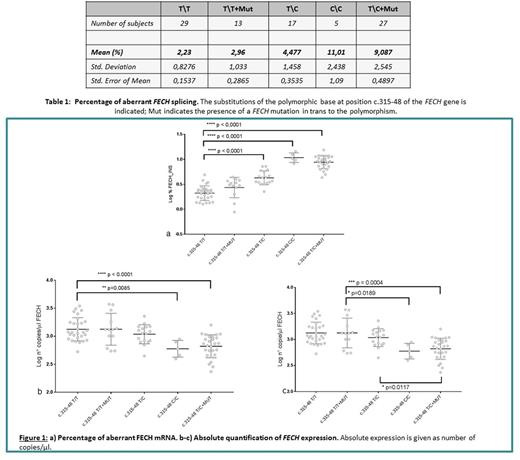Abstract
Ferrochelatase (FECH), the last enzyme of heme biosynthetic pathway, is responsible for the insertion of ferrous iron into protoporphyrin IX (PPIX) to form a molecule of heme. Mutations in the FECH gene cause Erythropoietic Protoporphyria (EPP, MIM#17700), which is clinically characterized by acute and painful cutaneous photosensibility and biochemically by the accumulation of PPIX in erythrocytes and plasma. The autosomal recessive form of EPP requires the presence of FECH mutations in homozygosis or a single mutation in trans to a 'low expressed allele'. This allele originates from an abnormal event of alternative splicing of FECH intron 3, creating an aberrant mRNA that has a non-sense mediated decay. The presence of the c.315-48T>C polymorphism in intron 3 is able to raise the physiologic amount of this aberrant splicing, causing EPP when associated to a FECH mutation.
To evaluate the role of the aberrant splicing on FECH expression, we developed a Digital PCR assay which allows to evaluate in vivo the absolute quantification of the aberrant splicing and the FECH global expression. In this study 91 subjects were analyzed: 27 EPP patients (c.315-48T>C+ mutation), 13 carrying only the FECH mutation, 17 carriers of c.315-48T>C, 5 homozygous for c.315-48T>C and 29 wild type subjects as control. Digital PCR on mRNA was performed in duplex with two differently labelled probes: one specific for the normal FECH mRNA; the second one was specifically designed to detect the inserted mRNA. Data analysis was performed with ordinary one-way ANOVA with Tukey-Dunnet's post-hoc test; nominal statistical significance was set at p<0.05.
We observed that the percentage of the aberrant mRNA is lower compared to what is reported in literature (Gouya et al. 2002 - Barman-Aksozen J. et al. 2013) both in wild type and in c.315-48T>C carriers, even thought the aberrant mRNA in the latter is doubled compared to the wild type (Tab.1). A significant difference was observed (Fig.1a) when comparing wild type class to other classes: vs c.315-48T>C (p<0.0001), vs homozygote for c.315-48T>C (p<0.0001) and vs c.315-48T>C+mut (p<0.0001). These data were confirmed when analyzing the number of single events of insertion. Interestingly, there was no significant difference between wild type subjects and carriers of FECH mutations.
Evaluating the total FECH expression, a significant difference were observed when comparing the wild type class vs c.315-48T>C+mut class (p<0.0001) and vs homozygotes for c.315-48T>C class (p=0.0085) (Fig.1b). The same was true when we compared the class of FECH mutation carriers vs c.315-48T>C+mut class (p=0.0004) and vs the class of homozygotes for c.315-48T>C (p=0.0189) (Fig. 1c). These data suggest that homozygosis for c.315-48T>C could be considered pathological. As a matter of fact in this cohort, 4 out of 5 homozygous cases for c.315-48T>C presented with typical clinical signs of EPP.
In conclusion, it is known that c.315-48T>C reduces the global FECH expression to a pathologic level when associated to a FECH mutation in trans, but alone in heterozygosity has no effect, whereas in homozygosis, the c.315-48T>C is able to reduce the FECH gene expression to a pathologic level, causing EPP phenotype.
Cappellini: Sanofi-Genzyme: Honoraria, Research Funding, Speakers Bureau; Novartis: Speakers Bureau; Celgene: Honoraria; Vifor: Honoraria.
Author notes
Asterisk with author names denotes non-ASH members.


